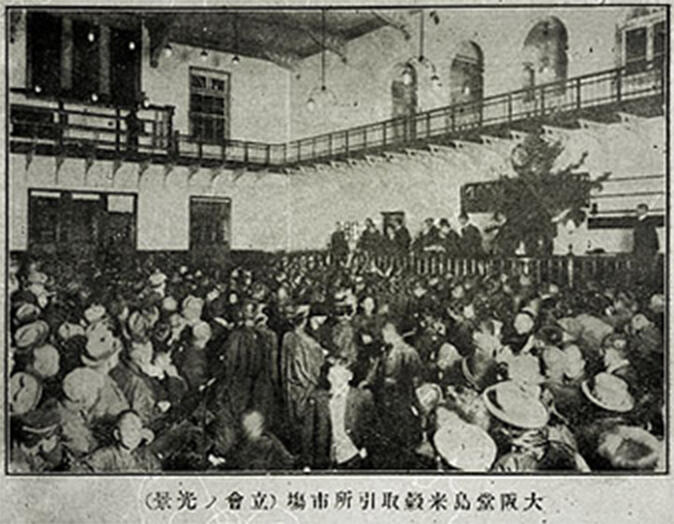The Birthplace of Futures Trading
The Origin of ODEX is in Mid-Edo Period.
In the Edo period, feudal domains collected the rice as tax. They sent these rice to Osaka and Edo for the purpose of cashing, except for the amount used for food and stockpiling. At that time, many of Kurayashiki(warehouse) were concentrated in Osaka and the rice stored there were sold to rice brokers through auctions. Securities called “Rice bills” which is issued for exchanging the rice were traded actively. It can be said rice was securitized. This rice bills also covered unharvested rice. And trading participants could trade futures by contract for difference simply by preparing a margin called “Shikigin”.
In 1730, a spot market to trade rice bills and a rice future market in Dojima(Dojima Rice Exchange)were authorized by the Edo shogunate. Dojima was equipped with a membership system and clearing function. And the rice price formed here was transferred to the major cities by couriers. Rules, customs and function in Dojima form the basis of that in the modern exchange. The CBOT (Chicago Board of Trade), which is the oldest commodity exchange in the United States and has the largest futures market in the world, is said to have been developed based on the Osaka Dojima market.

The rice at that time can be regarded as the main financial asset of people. DNA of Dojima Rice Exchange (which traded the rice as a futures contract) is being passed down to ODEX, which is currently aiming to develop a wide range of derivative financial products as a comprehensive exchange.
History
| Mid-17th century | Rice wholesaler Yodoya opens Yodoya Rice Market at the storefront on the south side of Osaka Yodoya Bridge |
|---|---|
| Around 1697 | Yodoya Rice Market moves to Dojima, which is on the opposite bank of Kitahama, and becomes Dojima Rice Exchange |
| 1730 | Under the reign of Yoshimune Tokugawa, the 8th Shogun of Edo Shogunate, the Dojima Rice Exchange that is the world’s first futures trading market started officially licensed by Ohoka Tadasuke. |
| 1869 | The Meiji government abolished Dojima Rice Exchange as a cause of soaring rice prices |
| 1871 | The revival of Dojima Rice Exchange is officially permitted |
| 1873 | Dojima Rice Exchange merged with Oil Exchange to form Dojima Rice and Oil Exchange (The name returned to Dojima Rice Exchange after that due to the abolishment of the Oil Exchange.) |
| 1876 | Dojima Rice Exchange became Osaka Dojima Rice Exchange by enacting the Rice Chamber of Commerce Regulations. |
| 1893 | Osaka Dojima Rice Exchange reorganized into Osaka Dojima Rice Exchange Co., Ltd. due to the enactment of the Exchange Law |
| 1939 | Osaka Dojima Rice Exchange was abolished by the enforcement of the Rice Distribution Control Law |
| 1952 | Osaka Grain Exchange was established |
| 1992 | Trading by computerized system started |
| 1993 | Osaka Grain Exchange, Osaka Sugar Exchange, and Kobe Grain Commodities Exchange mergerd to form Kansai Agricultural Commodities Exchange. |
| 1997 | Kansai Agricultural Commodity Exchange was merged with Kobe Raw Silk Exchange and renamed Kansai Commodity Exchange. |
| 2006 | Kansai Commodity Exchange merged with Fukuoka Commodities Exchange |
| 2011 | Rice futures trading has been started Kansai Commodity Exchange and Tokyo Grain Exchange |
| 2013 | Kansai Commodity Exchange renamed to Osaka Dojima Commodity Exchange by taking the opportunity of accepting the rice market of Tokyo Grain Exchange |
| April,2021 | Organizational Conversion from a Member Commodity Exchange to an Incorporated Commodity Exchange implemented and changed the name to Osaka Dojima Commodity Exchange, Inc. |
| August,2021 | Renamed to Osaka Dojima Exchange, Inc. |
| March,2023 | Opened Precious Metals Market and began Night session on the same market. |
| August,2024 | Opened Rice index Market. |
